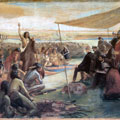Perspectives - First Nations

Historically, the First Nations who entered into Treaty 7 with representatives of Queen Victoria (or the Great Mother, as she was referred to at the talks) at Blackfoot Crossing came into the agreement with their own unique perspective of what the treaty was, what it meant, how it was to be discussed, and what agreeing to it entailed. It is important to note that the leaders of the First Nations that entered into the Treaty 7 talks believed that it was a peace treaty for all the First Nations and the British Crown. The reason that this point is so critical is because the making of a peace treaty between two parties was a sacred undertaking in First Nations culture. Before discussions began, a sacred smudge was performed in which sweetgrass was burned and prayers and sacred songs asking for guidance from the Creator were performed.
Following the smudge, a pipe was shared between the parties who were to discuss the terms together. The reason for this was that the pipe was a gift from the Creator, and those who smoked the pipe together were bound to speak truthfully to one another and to honour whatever was agreed to. According to the testimonies of the Treaty 7 Elders and Tribal Council in the book, The True Spirit and Original Intent of Treaty 7, these very ceremonies were performed before the Treaty 7 talks just as they would have been with any peace treaty arranged between the First Nations for generations long gone. However, there is no mention of these ceremonies in the official 1877 records of the event. The absence of the sacred ceremonies in the Treaty 7 records illustrates the deep lack of understanding held by those government officials who entered the negotiations.
A second major understanding brought to the table by First Nations leaders at Blackfoot Crossing was that what they were discussing involved the sharing of First Nations land with the European newcomers. If settlers were going to live on First Nations lands, then the First Nations had to be compensated for its use. This did not mean that the First Nations were ceding or surrendering their land to anyone, as the Treaty 7 documentation describes. Rather this was the perspective of a people who knew their relationship with the land and wished to talk terms about its use. Land was not a commodity to be given away in the eyes of the Treaty 7 First Nations. In the words of Kainai Chief Medicine Calf (also known as Button Chief) during a speech he made at the 1877 talks, “the Great Spirit, and not the Great Mother, gave us this land.”
The First Nations perspective of Treaty 7 sheds light on why the treaty remains a contentious issue for these First Nations in the present day. Historically, there has been frustration at the loss of land that was never intended to be given up, and sadness that the sacred oaths made at Blackfoot Crossing were not honoured by the Crown or its representatives. True understanding of what Treaty 7 is depends upon an acknowledgement of this perspective which the Treaty 7 First Nations feel has been officially ignored.




